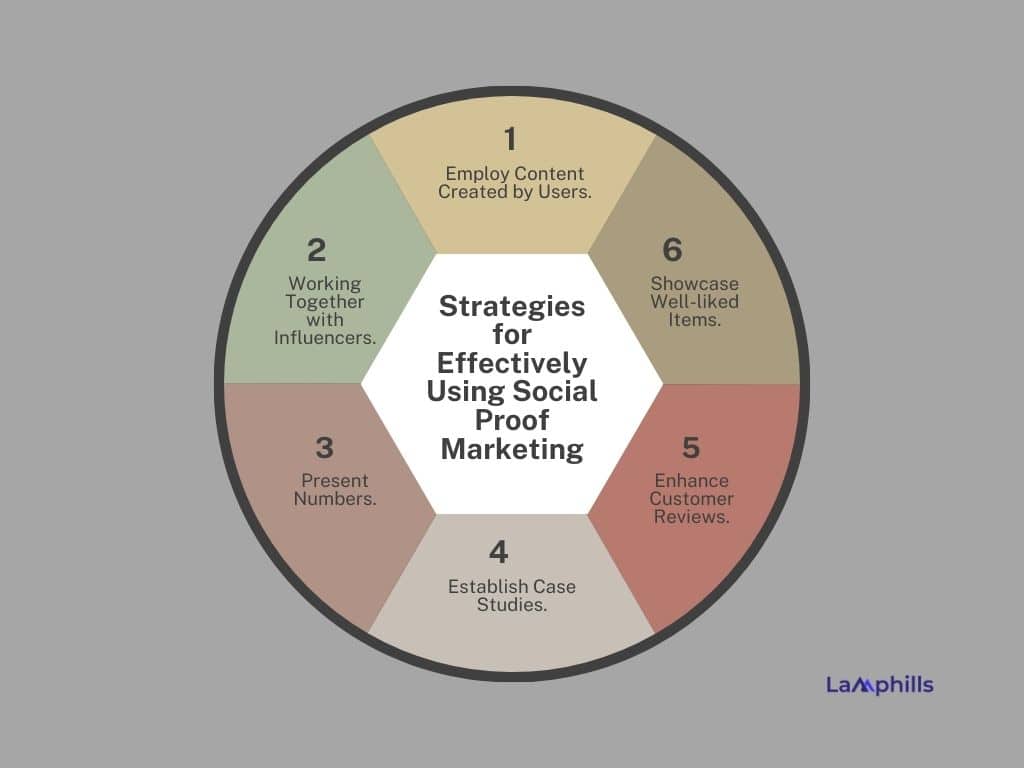One idea that is well-known for helping firms or enterprises that want to boost conversions is social proof. When social proof is effectively utilized, its impacts can be very positive. Are you more likely to buy an item because of many great reviews, or are you more motivated to try a new business because there are too many in-line consumers who bought the product? Social proof is the term used to describe this occurrence. Here, we will go deeper into social proof research and offer a strategy—along with examples—for utilizing social proof marketing to boost conversions.
Key Points
- Social proof increases the likelihood that a potential consumer will purchase by providing reassurance that others have had favorable experiences through the display of user-generated content, influencer endorsements, and customer reviews.
- Social proof comes in many forms, including case studies, testimonials, influencer endorsements, customer assessments, and social media engagement. Each form enhances credibility differently.
- To establish credibility and popularity, some effective strategies are to promote customer reviews, conduct campaigns using user-generated content, work with influencers, and show off sales figures or best-seller badges.
- Psychological triggers such as herd mentality and FOMO (fear of missing out) are utilized. People are more inclined to buy a product or promote it to others when they observe others doing so because it makes them feel good about their decision.
- Social proof is effective, but it needs to be real. Retaining openness and presenting genuine experiences is essential for long-term success since customers are fast to spot false evaluations or inauthentic references.
What Is Social Proof?
Understanding social proof is the first step in utilizing its effectiveness to increase conversions for your business. If a relative or close friend proposes a product, you’re prone to take the recommendation seriously. Social proof is the notion that people typically adhere to the conduct and views of others to make choices. In other words, it’s the concept that we tend to believe the views and behaviors of others around us over our instincts. This notion is psychological research. In reality, referrals from friends and family rank among the most significant sources of advertising, in line with the word-of-mouth report by Chatter Matters: 80% of customers claim that these suggestions increase their likelihood of purchasing a good or service.
Social proof marketing examples
Social proof comes in various forms in marketing, and depending on your business strategy, you can use different kinds of it. Examples of social proof marketing that could have significant impacts on your own business are as follows:
#1. The Expert’s Stamp of Approval
When a prominent figure in the business or influencer endorses your product, that is considered expert social proof. They might blog, post on social media, be featured in an article or photo as a product user, or all of these things.
#2. User Testimonials
Firms create case studies showcasing the successes their customers have had with their products because it is an act of trust in the product’s value. Different types of testimonials can have the same effect: whether they are customer reviews on the business’s website, reviews on external websites, star-based ratings, or comprehensive case studies, this content generates positive feedback from real users.
#3. Acquired Press
If your brand has been the subject of any positive news coverage, this earned media is a terrific method to increase brand recognition, backlinks pointing to your web page, and social proof that your company is legitimate.
#4. Celebrity Endorsement
This type of social proof usually consists of a celebrity endorsing a product in public or on social media; it is particularly significant if the recommendation is unpaid.
#5. The wisdom of your colleagues
“Knowledge from your friends.” The term “social proof” refers to the previously discussed phenomenon, which states that advice from persons we are familiar with is significantly more reliable than other forms of advertising or marketing.
#6. Commercial Qualifications
Business credentials can increase a product’s trustworthiness, just as consumer reviews can add value to it. Companies may highlight their accolades and qualifications, as well as information about their customer base and a list of well-known companies they have worked with. Sole proprietorships may even present their degree or education as a qualification that their clients should find noteworthy.
#7. The Crowd’s Wisdom
“The Crowd’s Wisdom” Our fear of missing out (FOMO) is satiated by social proof because when a lot of people use or purchase a product, others are tempted to do the same.
#8. Sharing on Social Media
Businesses should never undervalue the impact that social media posts about their brand can have on prospective consumers, even though the significance of website traffic derived from social media can differ substantially across them. If your article receives enough favorable shares on social media sites like Facebook, Instagram, LinkedIn, Twitter, and Facebook, it may be sufficient evidence for someone to buy your good or service.
Social proof marketing strategy
A psychological phenomenon known as social proof marketing occurs when people imitate the behavior of others, believing that this is the appropriate course of action. Put more simply, we are more inclined to give a product or service a try ourselves if we witness it becoming more well-liked or obtaining favorable reviews. In my experience as an Internet business owner, social proof marketing is among the most effective strategies for increasing audience trust and conversions. These are the tactics I took to make sure it worked and how it was useful in completely changing my little online business.
My First Social Proof Marketing Experience
That is, until I opened my internet store, I never gave social proof much thought. Originally, I was selling personalized goods like beauty soap, mugs, t-shirts, and phone covers. It was difficult for me to generate sales even with a respectable website design and aggressive pricing. Few to no traffic or conversions occurred throughout the weeks. I was constantly unsure what I was doing incorrectly, which was annoying. Also, I was not providing potential buyers with the assurance they required to trust my business until I came across an article on social proof marketing one day. I had no testimonials, no evaluations, and no means of proving whether others had bought and liked my stuff. That’s when it dawned on me: I needed to prove to them that other individuals were purchasing if I wanted them to.
Comprehending Social Proof Marketing
Using other people’s influence to convince potential buyers is known as social proof marketing. People are willing to use a thing themselves when they observe others using it or endorsing it. The worry of making a poor choice is diminished since it increases credibility and trust. Depending on your audience and brand, various types of social proof can be carefully employed. Typical examples include the following:
- Promoted by celebrities or influencers: Renown individuals endorsing or utilizing a product.
- Verification through Social Media: A significant quantity of likes, shares, or followers on social media sites.
- Material Created by Users: Articles, images, or videos uploaded by actual customers utilizing the merchandise.
- Case Studies: Comprehensive examination of a product’s or service’s benefits to others.
- Testimonials & Reviews from Customers: Affirmative comments from content clients.
The easiest to obtain and most valuable types of social proof, in my opinion, were user-generated material and consumer reviews. I came to understand that consumers placed significantly more faith in suggestions from others than in the company’s promotional claims.
Using Social Proof in My Marketing Approach
I began considering ways to include social proof in my marketing plan as soon as I realized how important it was. These are the following actions I took and the things I discovered along the road:
#1. Promoting User-Generated Content
I also encouraged my clients to post pictures of themselves utilizing my items on social media. I made a custom hashtag and held a competition where participants could post pictures of themselves using the hashtag to win free merchandise. This boosted social media interaction and gave me real user-generated material for my website. User-generated content provided prospective buyers with an authentic impression of the appearance and functionality of my items. Since it was real, it had much more persuading power than my edited product photographs. Consumers enjoy watching things in use, particularly when they are being used by frequent, recognizable consumers.
#2. Influencer Marketing on Social Media
In search of social evidence, I chose to investigate influencer marketing, which was becoming popular at the time. In my niche, I made contact with a few micro-influencers who had tiny but very active followings and offered them free merchandise in return for platform mentions or reviews. My site’s traffic increased significantly as a result of their followers’ faith in their thoughts. The fact that people were motivated so much by the support of someone they looked up to or followed shocked me the most. The power of this kind of social proof was demonstrated by the obvious increase in conversions that followed each post by an influencer.
#3. Developing Credibility Through Client Reviews
I started by contacting my current clients and asking them to provide frank reviews of the goods they had bought in exchange for discounts and exclusive offers. I was able to gather a respectable amount of reviews in a matter of weeks for my product pages. Because showing only flawless ratings might occasionally come across as suspicious, I made sure to highlight equally favorable and beneficial comments. Potential clients’ trust was improved by this openness. Additionally, I added a review widget to my website, which updated automatically with fresh comments, giving it a trustworthy and lively appearance.
#4. Success Stories and Case Studies
I began gathering information on how my items were benefiting clients as my firm expanded. I started releasing case studies and success stories that showed the beneficial effects of my products on people’s lives. Potential clients found it easier to make decisions when they could clearly understand the practical advantages of my offerings thanks to this kind of extensive social proof.
#5. Showcasing Well-Known Items
On my website, I saw that certain things just seemed to get more attention than others. I made the decision to add a “Best Sellers” area that showcased the most well-liked products according to sales, rather than managing all products equally. Because people were eager to get their hands on things that others were already buying, highlighting these products increased the perception of haste and FOMO (fear of missing out). Something just becomes more attractive by being given the title “popular.” Humans had an innate belief that something must be worthwhile if other people were purchasing it.
#6. How to Communicate Popularity with Numbers
Numbers have a lot of power over people. A crucial component of my approach was displaying the number of people who had previously bought or evaluated a product. Indicating that “250+ customers have purchased this product” or “4,000+ followers trust the brand,” for instance, reassured prospective shoppers that they were not the only ones thinking about making a purchase. I have included a little display signal on my web page to indicate when a purchase has been made. The environment these real-time messages generated allowed visitors to see that other people were purchasing my things, which increased conversions.
Difficulties and Insights Learned
Even with my achievements, there were difficulties in putting social proof into practice. I found that not all clients were willing to discuss their experiences or write evaluations. However, I had to simplify and make the procedure as satisfying as I could to get over this. I set up a system to remind people to review, and I offered loyalty points or discounts in return for reviews.
Retaining authenticity was another difficulty. It’s important to maintain authenticity despite the temptation to edit or perhaps enhance social proof. Consumers can detect phoniness in reviews and endorsements, which can backfire and breed mistrust. In the end, authenticity always comes out on top.
The Outcome: An Improvement in Conversions
My conversion rate significantly rose after concentrating on social proof marketing for six months. My website was being visited by more visitors, and they also had a higher likelihood of making a purchase. People were spending more time reading reviews, user-generated material, and success stories; therefore, my bounce rate decreased and the average session duration increased.
One satisfying outcome was probably the community that grew up around my brand. Clients were now more than simply purchasers; they were also brand ambassadors, spreading the word about my company and posting testimonials on social media.
Strategies for Effectively Using Social Proof Marketing
The following are the main tactics for successfully utilizing social proof marketing, based on my experience:
#1. Employ Content Created by Users
Urge your clients to post pictures and descriptions of themselves utilizing your product. Your brand becomes more relatable as a result.
#2. Working Together with Influencers
Assist influencers in your field to connect with more interested and large audiences. One can even be greatly influenced by micro-influencers.
#3. Present Numbers
Showcase the number of people who have bought, rated, or suggested your stuff. Trust and legitimacy are established by this quantitative social proof.
#4. Establish Case Studies
Provide thorough case studies that illustrate how your product works in the real world. These are relatable tales that lend trust to the company.
#5. Enhance Customer Reviews
Urge clients to submit reviews, then be sure you highlight them on your website. Sincere criticism and praise alike foster trust.
#6. Showcase Well-liked Items
Display the items that are most in-demand or best-selling. If someone knows that others are also buying something, they are more inclined to buy it.

How effective is social proof in marketing?
Due to its ability to capitalize on a basic trait of human nature, namely our inclination to imitate the actions of others, social proof is among the most successful marketing tactics. Individuals are more inclined to choose a product or service if they hear positive reviews from those who have used it. Two of the biggest obstacles to completing a purchase are uncertainty and confirmation, which social proof removes. Using social proof, in my experience, results in:
#1. Enhanced Customer Credibility
Visitors were reassured by social proof that my items were a worthwhile investment of both time and money. This tactic is effective because individuals generally respect other people’s ideas, particularly when they can see that other people share their requirements or preferences. Social proof reduces perceived risk and confirms that the purchase was a wise choice.
#2. Greater Rates of Conversion
Consumers were more inclined to make a purchase following social media mentions, reviews, or user-generated content. After adding social proof, my conversion rate more than doubled in the initial few months.
#3. Diminished Bounce Rates
When there were more social proof components on my website—such as client reviews or influencer endorsements—potential buyers spent more time there.
What is an example of social proof in marketing?
Various forms of social proof can be utilized based on your business strategy. There are numerous instances of social proof in marketing. Here’s an illustration that impacted my own business:
Client Evaluations and Feedback
Customer reviews are among the most effective and straightforward kinds of social evidence. Potential shoppers felt more at ease about purchasing from my store when I displayed frank, in-depth evaluations from actual customers. On my product pages, I prominently displayed both criticism and positive customer feedback.
As an illustration, on my Custom Beauty Soap product page, I included a section featuring customer testimonials. Sales were greatly boosted by comments like “This soap is amazing, and it scents nice!” By easing their fears, reading about the opinions of others encouraged potential buyers to make a purchase.
How do I generate social proof?
Although it takes time to generate social proof, you can begin gathering it quite rapidly if you use the appropriate tactics. This is how I produced social evidence for my company:
#1. Organize Competitions to Encourage User-Generated Content
One effective type of social proof is user-generated content. I held a social media competition to promote this, wherein clients could share pictures of themselves using my goods and tag my company to enter to win a freebie. I was able to upload a ton of real-life product images on my web page and social media accounts in addition to building discussion about my brand.
#2. Promote Feedback from customers
Requesting evaluations from your current clients is one of the simplest methods to build social proof. I streamlined the procedure by having automated follow-up emails sent a few days following each transaction, asking for feedback and a rating from the clients. I promised to give them a discount on their subsequent purchase if they left a review.
#3. Display Numbers
Individuals who have a track record of success tend to trust corporations. Metrics such as “250+ satisfied users” or “rated 4.9 stars by 4000 users” demonstrate a product’s popularity and reliability. These figures are what I made sure to highlight in my promotions and on my website.
#4. Team with Influencers
Another powerful strategy for creating social proof is to work with influencers. In my niche, I made contact with micro-influencers to provide them with freebies in return for site shout-outs or reviews. With their support, I was able to reach a wider and more interested audience and establish the legitimacy of my brand.
How does social proof build trust?
By demonstrating to prospective consumers that other people have tried, tested, and benefited from a good or service, social proof increases client confidence. In actuality, it operates as follows:
#1. Credibility via Relationships with Influencers
Influencer partnerships increased trust on top of it. My items felt natural and trustworthy when endorsed by influencers who genuinely appreciated them. Their suggestions were more likely to be believed by their followers than the self-promotional statements made by brands.
#2. Verification via Reviews
People’s concern about making a poor choice is lessened when they observe encouraging comments from others. Reviews testify to the product’s functionality and ability to live up to expectations. Customer testimonials turned into a critical component in helping my firm gain confidence. People felt more comfortable buying from me when they realized that other customers were happy with my products.
#3. FOMO and the Mindset of Herds
Social proof manipulates the population’s mindset and “fear of missing out” (FOMO). When a product is well-liked, people are more inclined to want it since they don’t want to pass up something worthwhile. Because it created a perception of haste and scarcity, adding a “best sellers” category to my site along with a “low stock” notice greatly increased conversions.
#4. User-Generated Content as a Source of Authenticity
Because it feels real, user-generated content is especially powerful. In a manner that expert marketing cannot match, the sight of actual people—just such as them—enjoying a product fosters trust. I provided prospective customers with reassurance that my products were of high quality and met their expectations by displaying images of real customers using them.
Conclusion
Effective usage of social proof marketing can significantly boost conversions and foster client loyalty. You may develop community, establish trust, and eventually expand your business by taking advantage of other people’s influence. This can be done through influencer relationships, user-generated content, or feedback. Making real interactions with your target market is more important than merely bragging, as my experience using social proof marketing has shown me.
Related Articles
- How to Create and Share User-Generated Content on Social Media (+ Examples)
- How to Market Yourself on Social Media: 10 Effective Strategies
- Conversion Marketing: Strategies to Boost Your Business Growth
- How To Drive Social Media Reviews: The Ultimate Guide
- The Power of Trust in Marketing: How to Build Strong Connections With Customers






